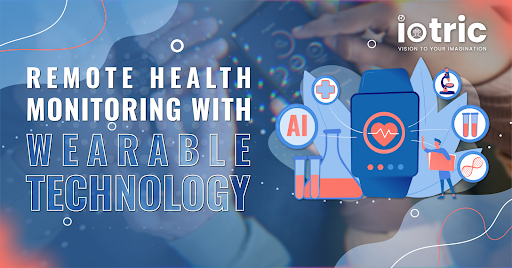Uncategorized
Remote Health Monitoring with Wearable Technology

Integrating wearable devices, big data, and artificial intelligence (AI) has transformed remote healthcare and patient monitoring. These technologies enable the continuous, real-time collection of physiological and behavioral data, allowing healthcare providers to track patients’ health remotely.
Devices like smartwatches, fitness trackers, and medical sensors can monitor vital signs, physical activity, and sleep patterns. In this article, we will understand how these technologies are evolving health monitoring systems synergistically:
What is Wearable technology?
Wearable technology refers to electronic devices or gadgets designed to be worn on the body, either as accessories, embedded in clothing, or implanted in the skin. These devices typically have sensors, processors, and communication capabilities, enabling them to collect data, monitor activities, and interact with other systems. Wearable technology is widely used in various domains, including health, fitness, entertainment, and communication.
Wearable technology in Remote Health Monitoring
The implementation of wearable technology (ubiquitous wireless devices) for continuous vital sign monitoring has the potential to transform patient care by enabling timely intervention when clinical deterioration occurs, ultimately improving patient outcomes.
These devices allow for:
- Constant health surveillance,
- Providing real-time data that can alert healthcare professionals to changes in a patient’s condition,
- Ensuring that necessary actions are taken promptly to prevent complications,
- And support better recovery.
Role of AI in Wearable Technology-based Remote Health Monitoring
AI is essential in processing the vast amount of data collected from wearable devices by using sophisticated algorithms for analysis, pattern detection, and predictive modeling. This collaboration between wearable technology, big data, and AI not only encourages patients to take an active role in managing their health, but also equips healthcare providers with the tools to make informed decisions, identify abnormalities, and deliver timely interventions.
This integration of AI with big data allows for the automation of complex tasks, such as detecting subtle changes in health metrics, providing early warnings for potential conditions, and offering personalized health insights and recommendations tailored to an individual’s specific needs.

Benefits Of AI, Big Data, And Wearable Technology
The synergy between AI, big data, and wearable technology has far-reaching benefits.
- Real-time Healthcare: For patients, it means a greater sense of control and involvement in their health management. They can receive real-time feedback on their lifestyle choices, such as exercise habits or diet, and make informed adjustments to improve their well-being.
- Data-Driven Decision-Making: On the other hand, healthcare professionals are equipped with comprehensive and actionable data, enabling them to make data-driven decisions, track long-term health trends, and intervene before minor issues escalate into serious conditions.
- Proactive Care: Additionally, the predictive capabilities of AI help in proactive care. For instance, by analyzing patterns in heart rate, blood pressure, or oxygen levels, AI can forecast potential risks like heart attacks or strokes and alert both the patient and healthcare provider for preemptive action.
This early detection and response system enhances patient outcomes, reduces hospital readmissions, and contributes to more efficient healthcare delivery. As this technology evolves, we can expect even greater innovations in remote patient monitoring and personalized healthcare solutions.
Related Applications Based On Remote Health Monitoring Using Wearable Technology
Wearable wireless devices for continuous vital sign monitoring are becoming increasingly prevalent in the medical field. These devices allow for early intervention by facilitating the rapid detection of clinical deterioration. They enable healthcare providers to diagnose and address potential issues promptly, which can help prevent complications and improve patient outcomes.
It contributes following applications:
Glucose Monitoring
Glucose monitoring refers to the use of wearable devices to track and manage blood sugar levels in people with diabetes. The concept of utilizing fully noninvasive technology, such as wearable devices, for this purpose, is still relatively new and in the early stages of development.
Several studies have explored the effectiveness of wearable devices that use artificial intelligence (AI) to predict or forecast blood glucose levels, aiming to improve accuracy and provide real-time insights for better diabetes management.
Cancer Tracking
Cancer treatment tracking, which focuses on monitoring the effectiveness of treatments and the patient’s response, is a critical aspect of cancer care. Research has shown that patient-reported outcomes and symptom monitoring play a significant role in this process.
As it offers real-time insights into the patient’s quality of life and any symptoms experienced during treatment. It further helps healthcare providers make informed decisions, adjust treatments as needed, and improve overall patient care by addressing both clinical progress and the patient’s well-being.
Post-surgery Care
Postoperative care is crucial to a patient’s recovery, and several factors impact its quality and patient satisfaction. Engaging patients in decisions about the timing and nature of their interactions with healthcare services can lead to a more personalized, patient-centered approach.
Additionally, preoperative assessments should consider variables such as age, gender, mental health status, and health literacy, as these factors can influence a patient’s recovery after surgery. By addressing these aspects, healthcare providers can better support patients through their postoperative journey, leading to improved outcomes and higher satisfaction.
Heart-Rate Tracking
Wearable technology for tracking heart rate is widely used in healthcare, fitness, and lifestyle applications. These devices typically employ sensors to monitor heart activity and provide real-time data about your heart rate, which can be used to assess fitness levels, detect abnormalities, or guide health decisions.
Additionally, they are used to optimize workouts, monitor stress, and detect heart conditions like arrhythmias, making them valuable tools for both fitness enthusiasts and individuals managing health conditions.
Conclusion
The integration of wearable wireless devices into healthcare is revolutionizing the monitoring of vital signs, enabling real-time, continuous surveillance. This technology enhances patient care by allowing for the early detection of clinical deterioration, leading to timely interventions and improved health outcomes.
As wearable devices and their underlying technologies are improved, they hold the potential to further transform patient monitoring and contribute to more proactive, personalized healthcare.